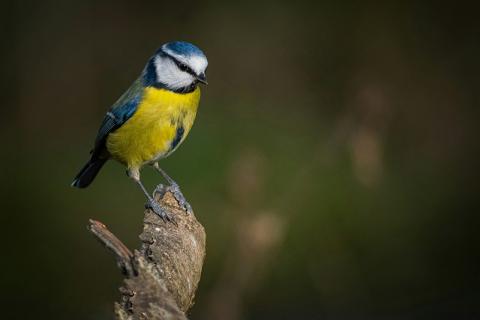Two approaches are being used at Alice Holt forest in southern England to gather data on bird populations, as Alice Holt’s ECN site manager, Caitlin Lewis of Forest Research, reports.
Several changes in woodland structure since the last bird surveys were conducted at Alice Holt present us with an opportunity to explore whether the ways bird communities using the woodland have changed in response. The woodland area has undergone several management changes since the last common bird survey in 2009. Much of the survey area was thinned around 2014, and the conifer belt around the woodland edge was felled and is now an open scrub area. The central part of the survey area has been left unmanaged since 1993 and now has many fallen, dead ash trees since the introduction of Chalara fungus (Hymenoscyphus fraxineus or ash dieback) around 2012. The changes in the woodland edge are expected to be favourable for bird diversity, and changes in the unmanaged area favourable for rarer woodland birds.
EdgeAI for bat and bird monitoring
Innovative acoustic recording devices are being installed at Alice Holt in 2024 to record bat and bird activity across the woodland. The devices will be aligned with other biodiversity-surveying efforts in the forest, such as soil biodiversity sampling, alongside the long-term monitoring of air pollution, forest condition, and biodiversity within the ECN and ICP Forests Level II frameworks.
The acoustic monitoring devices, developed by the Internet of Things department, in the Information Services Group at the University of Edinburgh, currently use an Audiomoth microphone coupled with a Raspberry Pi computer. Detected sounds instantly pass through an algorithm that calculates the likelihood of a particular sound being a particular species. That information is then transmitted via a LoraWAN gateway device to a cloud-hosted web portal with built-in tools to facilitate easy data visualisation.
The setup of the technology allows easy integration of open-source algorithms to expand the range of identifiable sounds; we are currently using the BirdNET platform to classify bird sounds, for example, and the modular design of the device allows the microphone to be switched out to test other developing technologies.
The automated, real-time processing overcomes some of the challenges associated with acoustic monitoring, such as the management of raw audio files, but we acknowledge the limitations of a developing technology. Work remains to test and develop the algorithms adopted, as well as testing the sensitivity of the devices in woodland environments. At Alice Holt, the devices will be deployed in several management scenarios: (1) open field, (2) unmanaged woodland, (3) managed unthinned woodland, (4) thinned woodland with an understorey, (5) thinned woodland without an understorey, (6) woodland edge near urban infrastructure, (7) woodland edge near agricultural land, and (8) woodland edge near a pond.
The work is supported by a NERC-Defra Innovations in Environmental Monitoring grant.
Repeating the Common Birds Census
In addition to the acoustic work, for the first time since 2009 a Common Birds Census (CBC) was conducted at Alice Holt in 2024 by contractor, George Ridgeway. The CBC methodology was previously developed by the British Trust for Ornithology for national-scale surveys but discontinued in favour of the less time-demanding Breeding Bird Survey (BBS). ECN contributed to the BTO’s CBC when it was run, and then the BBS. The BBS was continued in Alice Holt until 2015, but whilst effective at national-scale, the BBS method involves only two visits per year so cannot provide detailed information on a site scale, unlike the CBC.
On 10 visits between May-June 2024, the surveyor recorded bird species and activity in 16 grid squares, originally mapped out in the surveys pre-2009. The spatial information collected on the bird sightings highlights how different species use spaces within the woodland. Whilst blackbirds, wrens and blue tits were present across the survey area, chiff chaffs were more frequently observed in the more open areas and great tits, marsh tits, coal tits and woodpeckers observed deeper in the woodland. Marsh tits were recorded twice; they were not previously recorded via the CBS at Alice Holt, but they are notoriously difficult to identify during surveys. Prior to the survey, the Hampshire Ornithological Trust informed us that they had recorded several marsh tits during their 2023 county-wide marsh tit survey which used a playback methodology, a more effective way to assess numbers.
We hope to continue bird surveys for the next three years to allow a more robust comparison with previous years. In addition, we hope to digitise the maps created of sightings during the previous surveys to extract information on whether habitat use by birds has changed with changes in woodland management.
The traditional surveying methods alongside the adoption of EdgeAI-supported acoustic monitoring provides an opportunity to compare whether different methods will lead to different conclusions on species abundance and diversity, and eventually assess the suitability of new technologies to support environmental monitoring initiatives.
Further information
[Photo: Photo by Phil Robson on Unsplash]
